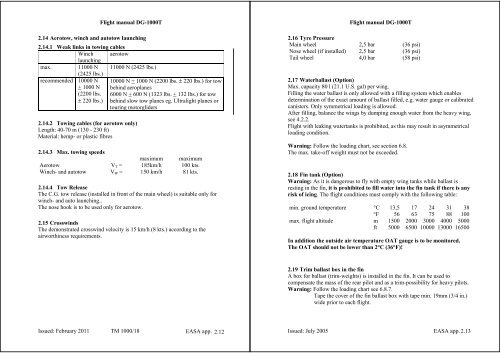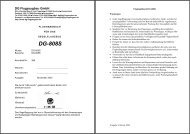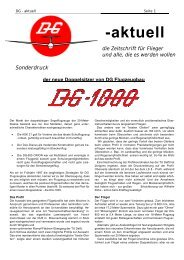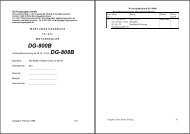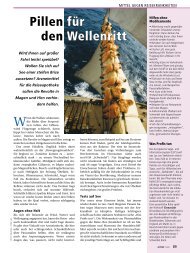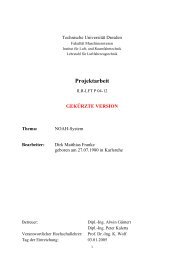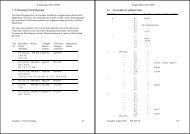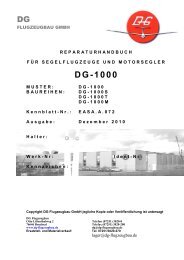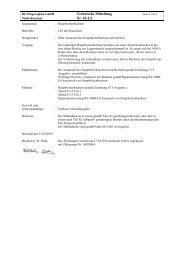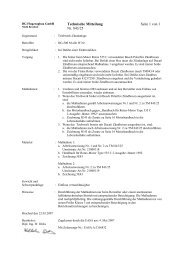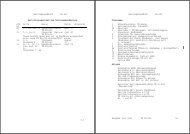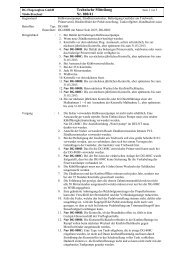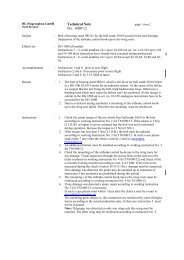DG-1000T - DG Flugzeugbau
DG-1000T - DG Flugzeugbau
DG-1000T - DG Flugzeugbau
You also want an ePaper? Increase the reach of your titles
YUMPU automatically turns print PDFs into web optimized ePapers that Google loves.
Flight manual <strong>DG</strong>-<strong>1000T</strong><br />
2.14 Aerotow, winch and autotow launching<br />
2.14.1 Weak links in towing cables<br />
Winch<br />
launching<br />
aerotow<br />
max. 11000 N<br />
(2425 lbs.)<br />
11000 N (2425 lbs.)<br />
recommended 10000 N 10000 N + 1000 N (2200 lbs. ± 220 lbs.) for tow<br />
+ 1000 N behind aeroplanes<br />
(2200 lbs. 6000 N + 600 N (1323 lbs. + 132 lbs.) for tow<br />
± 220 lbs.) behind slow tow planes eg. Ultralight planes or<br />
touring motorgliders<br />
2.14.2 Towing cables (for aerotow only)<br />
Length: 40-70 m (130 - 230 ft)<br />
Material: hemp- or plastic fibres<br />
2.14.3 Max. towing speeds<br />
maximum maximum<br />
Aerotow VT = 185km/h 100 kts.<br />
Winch- and autotow VW = 150 km/h 81 kts.<br />
2.14.4 Tow Release<br />
The C.G. tow release (installed in front of the main wheel) is suitable only for<br />
winch- and auto launching..<br />
The nose hook is to be used only for aerotow.<br />
2.15 Crosswinds<br />
The demonstrated crosswind velocity is 15 km/h (8 kts.) according to the<br />
airworthiness requirements.<br />
Issued: February 2011 TM 1000/18 EASA app. 2.12<br />
Flight manual <strong>DG</strong>-<strong>1000T</strong><br />
2.16 Tyre Pressure<br />
Main wheel 2,5 bar (36 psi)<br />
Nose wheel (if installed) 2,5 bar (36 psi)<br />
Tail wheel 4,0 bar (58 psi)<br />
2.17 Waterballast (Option)<br />
Max. capacity 80 l (21.1 U.S. gal) per wing.<br />
Filling the water ballast is only allowed with a filling system which enables<br />
determination of the exact amount of ballast filled, e.g. water gauge or calibrated<br />
canisters. Only symmetrical loading is allowed.<br />
After filling, balance the wings by dumping enough water from the heavy wing,<br />
see 4.2.2.<br />
Flight with leaking watertanks is prohibited, as this may result in asymmetrical<br />
loading condition.<br />
Warning: Follow the loading chart, see section 6.8.<br />
The max. take-off weight must not be exceeded.<br />
2.18 Fin tank (Option)<br />
Warning: As it is dangerous to fly with empty wing tanks while ballast is<br />
resting in the fin, it is prohibited to fill water into the fin tank if there is any<br />
risk of icing. The flight conditions must comply with the following table:<br />
min. ground temperature °C 13,5 17 24 31 38<br />
°F 56 63 75 88 100<br />
max. flight altitude m 1500 2000 3000 4000 5000<br />
ft 5000 6500 10000 13000 16500<br />
In addition the outside air temperature OAT gauge is to be monitored.<br />
The OAT should not be lower than 2°C (36°F)!<br />
2.19 Trim ballast box in the fin<br />
A box for ballast (trim-weights) is installed in the fin. It can be used to<br />
compensate the mass of the rear pilot and as a trim-possibility for heavy pilots.<br />
Warning: Follow the loading chart see 6.8.7.<br />
Tape the cover of the fin ballast box with tape min. 19mm (3/4 in.)<br />
wide prior to each flight.<br />
Issued: July 2005 EASA app. 2.13


